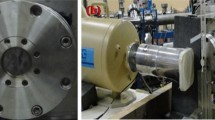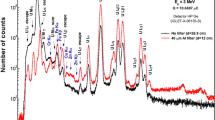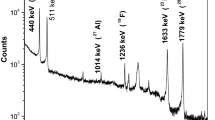Abstract
The quantitative determination of Li, Be, B, F is feasible using a sensitive and non-destructive method by the analysis of the prompt γ-rays induced with charged particles (PIGE). The irradiation source is a Van de Graaff accelerator, and γ-analysis has to be performed during the irradiation. Measurements were made at the CERI laboratory in Orléans with the PIGE method using a 100×300 μm2 focused beam of 3MeV α particles. Among the applications, micas along a drill core from the Beauvoir granite were analyzed. Bulk analyses of light elements in the drill core have previously been made. Coarse-grained micas were selected, individually irradiated and directly analyzed in polished thin sections from different elevations in the drill core. The sensitivity depends on the cross-sections of the nuclear reactions, on the particle current and on the duration of the irradiation. With a particle current irradiation of 25 nA during 1000 seconds, a 20 ppm limit of detection is reached for Be, 25 ppm for Li, 900 ppm for B and 450 ppm for F. A large variation of Be contents in the micas was found at equal drill hole elevations, and there was no strong correlation between whole-rock compositions and the mineral chemistry. The latter have been determined both by PIGE and by mineral separation and ICP analyses. On the other hand, a strong Li−F correlation was observed between the fluor-polylithionite and muscovite end-members, supporting previous analyses from equal elevation wells on sorted micas. Be−Li correlation is poorly defined, but the contents of the micas analyzed remained between the contents of bityite (Be−Li bearing mica) and lepidolites (Li-bearing micas) end-members. This suggests a solid-solution between the end-members, the extent of which is very narrow because the Be contents were not higher than 500 ppm. The detection limit is a function of the spatial resolution, because the current of the incident α (or p) particles decreases with the impact size. The results show that the analysis of small individual grains of minerals with PIGE can thus be complementary to other analytical methods such as the electronic microprobe.
Similar content being viewed by others
References
G. AUBERT, Mémoire BRGM No. 46, 1969.
M. AZARRAH, Thèse de Doctorat d'Université, Clermont-Ferrand, France, 1993.
M. BASUTÇU, J.-N. BARRANDON, M. VOLFINGER, J.-L. ROBERT, Chem. Geol., 40 (1983) 353.
H. BLANK, K. TRAXEL, Scanning Electron Microscope, Vol. III, 1984, p. 1089.
B. BORDERIE, J.-N. BARRANDON, Rev. d'Archéométrie, 1 (1977) 35.
B. BORDERIE, Thèse d'Etat, Orsay, 1978.
M. CUNEY, A. AUTRAN, Mémoire GPF, Vol. 1, 1987, p. 7.
G. DECONNINCK, J. Radioanal. Chem., 12 (1972) 157.
M. FONTEILLES, Mémoire, GPF, Vol. 1, 1987, p. 149.
M. FONTEILLES, Documents du BRGM No. 124, Programme GPF, 1988, p. 251.
C. GALET, Diplôme d'Etudes Approfondies, Orléans, 1989.
J. HALFON et al., Compte-rendu de fin d'études DGRST, BRGM No. 77 SGN 411 MGA, 1977.
K. ISHII, M. VALLADON, J.-L. DEBRUN, Nucl. Instr. Methods, 150 (1978) 213.
S. A. E. JOHANSSON, J. L. CAMPBELL, Micro PIXE, in: A Novel Technique for Elemental Analysis, John Wiley & Sons Ltd., 1988, p. 272.
G. MONIER, B. CHAROY, M. CUNEY, D. OHNENSTETTER, J.-L. ROBERT, Mém. GPF, Vol. 1, No. 2-3, 1987.
M. PICHAVANT et al., in: Magmatic Processes: Physicochemical Principles, B. O. MYSEN (Ed.), Geochemical Society, Special Publication, 1987, p. 359.
PH. ROSSI, A. AUTRAN, C. AZENCOTT, L. BURNOL, M. CUNEY, V. JOHAN, A. KOSAKEVITCH, D. OHNENSTETTER, G. MONIER, P. PIANTONE, L. RAIMBAULT, L. VIALLEFOND, Mémoire GPF, Vol. 1, 1987, p. 111.
PH. ROSSI, A. AUTRAN, C. AZENCOTT, K. GOVINDARAJU, G. MONIER, L. RAIMBAULT, J.-C. SAUGUES, L. VIALLEFOND, Documents du BRGM No. 124, programme GPF, 1988 p. 323.
J. SCHERER, K. TRAXEL, B. POVH, U. BRAUN, Max-Planck-Institut für Kemphysik, Heidelberg. Jahresbericht, 1985, p. 26.
R. WANG, Thèse de doctorat de l'Université Paul Sabatier, Toulouse, 1988.
J. F. ZIEGLER, J. P. BIERSACK, V. LITTMARCK, The Stopping and Ranges of Ions in Solids, Pergamon Press, 1985.
J. F. ZIEGLER, G. CUOMO, J. P. BIERSACK, The Stopping and Ranges of Ions in Matter, Computer Code TRIM88, 1988.
E. ZINE, D. B. ISABELLE, G. REMOND, Nucl. Instr. Methods, B 49 (1990) 446.
Author information
Authors and Affiliations
Rights and permissions
About this article
Cite this article
Volfinger, M., Robert, J.L. Particle-induced-gamma-ray-emission spectrometry applied to the determination of light elements in individual grains of granite minerals. Journal of Radioanalytical and Nuclear Chemistry, Articles 185, 273–291 (1994). https://doi.org/10.1007/BF02041301
Received:
Issue Date:
DOI: https://doi.org/10.1007/BF02041301




